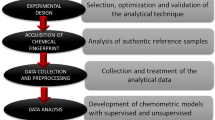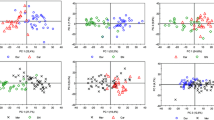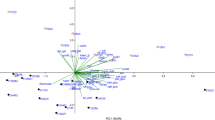Abstract
The objective of this study was to determine which major grape varieties are present in a given wine using both high-performance thin-layer chromatography (HPTLC) fingerprinting and multivariate analysis. For this purpose, 40 mono- and multi-varietal commercial wine samples from four vintages between 2003 and 2012 were collected and analyzed for their polyphenolic composition using HPTLC peak profiles. Polyphenolic compounds such as gallic acid, caffeic acid, resveratrol and rutin (each belonging to one of the four common classes of wine polyphenolic antioxidants) were identified. Unsupervised chemometric method, principal component analysis was used to analyze variance in HPTLC patterns as a function of wine grape variety. An artificial neutral network, as the efficient supervised chemometric tool, was used to develop a predictive model for classification of wine samples and discrimination between them.



Similar content being viewed by others
References
Armanino C, Casolino MC, Casale M, Forina M (2008) Modelling aroma of three Italian red wines by headspace-mass spectrometry and potential functions. Anal Chim Acta 614(2):134–142
Koundouras S, Marinos V, Gkoulioti A, Kotseridis Y, van Leeuwen C (2006) Influence of vineyard location and vine water status on fruit maturation of nonirrigated cv. Agiorgitiko (Vitis vinifera L.). Effects on wine phenolic and aroma components. J Agric Food Chem 54(14):5077–5086
Sabon I, de Revel G, Kotseridis Y, Bertrand A (2002) Determination of volatile compounds in Grenache wines in relation with different terroirs in the Rhone Valley. J Agric Food Chem 50(22):6341–6345
Esti M, Tamborra P (2006) Influence of winemaking techniques on aroma precursors. Anal Chim Acta 563(1–2):173–179
Hosu AD, Cimpoiu C, Pop N, Miclaus V, Bolboaca SD, Jantschi L (2011) The analysis of different factors affecting the red wines antioxidant content. Not Bot Hort Agrobot Cluj 39(1):159–164
Faria M, Nunes E, Oliveira MP (2008) Relative quantification of Vitis vinifera L. varieties in musts by microsatellite DNA analysis. Eur Food Res Technol 227(3):845–850
Ogegbo OL, Eyob S, Parmar S, Wang Z-T, Annie Bligh SW (2012) Metabolomics of four TCM herbal products: application of HPTLC analysis. Anal Methods 4(8):2522–2527
Morlock G, Schwack W (2008) Planar chromatography-back to the future? LC GC Eur 21(7):366–371
Milojković-Opsenica D, Ristivojević P, Andrić F, Trifković J (2013) Planar chromatographic systems in pattern recognition and fingerprint analysis. Chromatographia 76(19–20):1239–1247
Gonzalez-San Jose ML, Santa Maria G, Diez C (1990) Anthocyanins as parameters for differentiating wines by grape variety, wine-growing region, and wine-making methods. J Food Compos Anal 3:54–66
Spangenberg B, Poole CF, Weins C (2011) Quantitative thin-layer chromatography: a practical survey. Springer, Berlin
Agatonovic-Kustrin S, Morton DW, Yusof AP (2016) Development and validation of a simple high performance thin layer chromatography method combined with direct 1,1-diphenyl-2-picrylhydrazyl assay to quantify free radical scavenging activity in wine. Food Chem 197(Part A):285–290
Hess AVI (2007) Digitally enhanced thin-layer chromatography: an inexpensive, new technique for qualitative and quantitative analysis. J Chem Educ 84(5):842
Zarzycki PK, Ślączka MM, Zarzycka MB, Włodarczyk E, Baran MJ (2012) Application of micro-thin-layer chromatography as a simple fractionation tool for fast screening of raw extracts derived from complex biological, pharmaceutical and environmental samples. Anal Chim Acta 716:54–60
Olech M, Komsta Ł, Nowak R, Cieśla Ł, Waksmundzka-Hajnos M (2012) Investigation of antiradical activity of plant material by thin-layer chromatography with image processing. Food Chem 132(1):549–553
Komsta L (2012) Chemometrics in fingerprinting by means of thin layer chromatography. Chromatogr Res Int 2012:5. doi:10.1155/2012/893246
Daszykowski M, Stanimirova I, Bodzon-Kulakowska A, Silberring J, Lubec G, Walczak B (2007) Start-to-end processing of two-dimensional gel electrophoretic images. J Chromatogr A 1158(1–2):306–317
Wong KH, Razmovski-Naumovski V, Li KM, Li GQ, Chan K (2014) Differentiating Puerariae Lobatae Radix and Puerariae Thomsonii Radix using HPTLC coupled with multivariate classification analyses. J Pharm Biomed Anal 95:11–19
Fuller WA (1996) Introduction to statistical time series. Wiley, New York
Mendoza L, Matsuhiro B, Aguirre MJ, Isaacs M, Sotés G, Cotoras M, Melo R (2011) Characterization of phenolic acids profile from chilean red wines by high-performance liquid chromatography. J Chil Chem Soc 56(2):688–691
Rossouw M, Marais J (2004) The phenolic composition of South African Pinotage, Shiraz and Cabernet Sauvignon wines. S Afr J Enol Vitic 25(2):94–104
Ristivojević P, Andrić FL, Trifković JĐ, Vovk I, Stanisavljević LŽ, Tešić ŽL, Milojković-Opsenica DM (2014) Pattern recognition methods and multivariate image analysis in HPTLC fingerprinting of propolis extracts. J Chemom 28(4):301–310
Agatonovic-Kustrin S, Hettiarachchi CG, Morton DW, Razic S (2015) Analysis of phenolics in wine by high performance thin-layer chromatography with gradient elution and high resolution plate imaging. J Pharm Biomed Anal 102:93–99
Wikel JH, Dow ER (1993) The use of neural networks for variable selection in QSAR. Bioorg Med Chem Lett 3(4):645–651
Duprat AF, Huynh T, Dreyfus G (1998) Toward a principled methodology for neural network design and performance evaluation in QSAR. Application to the prediction of LogP. J Chem Inf Comput Sci 38(4):586–594
Haykin S (1999) Neural networks: a comprehensive foundation. Prentice-Hall, Englewood
Prial FJ (1997) Wine talk. The New York Times, New York
Jackson RS (2014) Wine science: principles and applications, 4th edn. Elsevier, Burlington
Robinson J (2006) The Oxford companion to wine. Oxford Univeristy Press, Oxford
Author information
Authors and Affiliations
Corresponding author
Ethics declarations
Conflict of interest
The authors declare there is no conflict of interest.
Compliance with Ethics Requirements
This article does not contain any studies with human or animal subjects.
Rights and permissions
About this article
Cite this article
Agatonovic-Kustrin, S., Milojković-Opsenica, D., Morton, D.W. et al. Chemometric characterization of wines according to their HPTLC fingerprints. Eur Food Res Technol 243, 659–667 (2017). https://doi.org/10.1007/s00217-016-2779-9
Received:
Revised:
Accepted:
Published:
Issue Date:
DOI: https://doi.org/10.1007/s00217-016-2779-9




